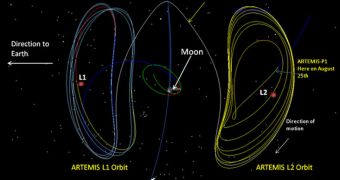The two ARTEMIS spacecraft NASA wants to put in lunar orbit have nearly reached their destination, officials from the American space agency announce. The probes have been flying towards the Moon for more than 18 months now.
In the mean time, they carried out in excess of 90 orbital maneuvers, in addition to a large number of gravitational boosts. While doing so, they consumed only minimal amounts of fuel from their very limited supplies.
Originally, they were orbiting our planet, but NASA eventually decided to transfer the two to lunar orbit. While moving through space, the spacecraft pass through orbits that were never attempted before.
They also transferred between a large number of orbits, validating extensive and complex calculations made by NASA mission managers. Since they proved that this can be done, other spacecraft may now start using those orbits as well.
When first launched, the two probes were a part of a five-satellite constellation called the Time History of Events and Macroscale Interaction during Substorms (THEMIS) mission, whose main goal was to study planetary auroras.
Once the THEMIS mission was done, experts at NASA decided to put two of the spacecraft to good use, in the ARTEMIS project. Despite the massive level of experience that NASA orbital engineers have, they still found it very difficult to put the satellites through their respective orbits.
"No one has ever tried this orbit before, it's an Earth-moon libration orbit," says David Folta a flight dynamics engineer at NASA's Goddard Space Flight Center in Greenbelt, Md. "It's a very unstable orbit that requires daily attention and constant adjustments."
ARTEMIS principal Investigator Vassilis Angelopoulos, from the University of California in Los Angeles (UCLA), was the first to propose the lunar transfer, but he also realized that conventional boosting techniques would not work, and that the spacecraft would consume all fuel in the process.
After the current transfer procedure was set into motion, the team began analyzing the science mission that lay ahead for ARTEMIS. “It's a veritable zoo of plasma phenomena on the Moon,” explains THEMIS/ARTEMIS project manager David Sibeck.
“The Moon carves out a cavity in the solar wind, and then we get to watch how that fills in. It's anything but boring. There's microphysics and particle physics and wave particle interaction and boundaries and layers,” he adds.
“All things we haven't had a chance to study before in the plasma,” concludes the expert, who is based at the NASA Goddard Space Flight Center (GSFC), in Greenbelt, Maryland.

 14 DAY TRIAL //
14 DAY TRIAL //